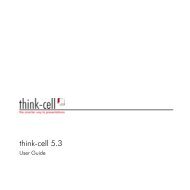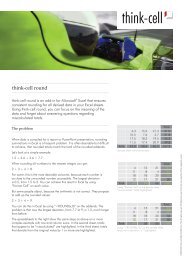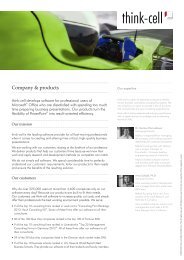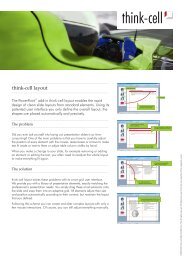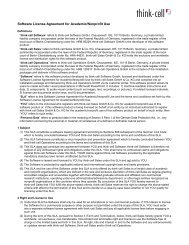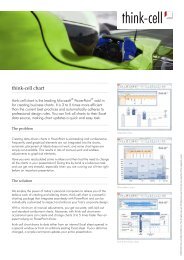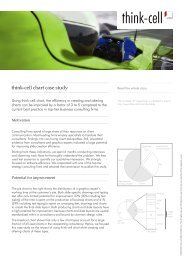think-cell technical report TC2003/01 A GUI-based Interaction ...
think-cell technical report TC2003/01 A GUI-based Interaction ...
think-cell technical report TC2003/01 A GUI-based Interaction ...
You also want an ePaper? Increase the reach of your titles
YUMPU automatically turns print PDFs into web optimized ePapers that Google loves.
2 Field Study<br />
FIELD STUDY<br />
Jeff Hawkins (PalmPilot inventor) 3 : “When I design products, I pretend<br />
to use them as much as possible before they exist. Meaning, I would put<br />
the wood prototype in my shirt pocket and carry it around all the time. If<br />
someone phoned, I’d take it out and pretend I was looking up something<br />
in the calendar or address book.”<br />
In my case, to acquire a thorough understanding of the problems for which my<br />
work attempts to offer a solution, I can do even more than Hawkins with his wooden<br />
“prototype”. Since the <strong>think</strong>-<strong>cell</strong> product is an extension to Microsoft PowerPoint,<br />
I could go and watch PowerPoint users in the target setting. A pilot customer of<br />
the <strong>think</strong>-<strong>cell</strong> company – a mid-sized consultancy office – provided an opportunity<br />
for me to do exactly that. The results are presented in this chapter.<br />
2.1 Qualitative Aspects<br />
Before we can even <strong>think</strong> about a quantitative evaluation we need some terminol-<br />
ogy and some basic understanding of the ongoing processes that involve Microsoft<br />
PowerPoint in the context of consultancies. A qualitative study provides the domain<br />
knowledge or the scale, which can be used to conduct a quantitative evaluation. In<br />
order to use time economically, I collected some quantitative data along with the<br />
qualitative study. However, the results are presented in distinct sections.<br />
2.1.1 Questions and Methods<br />
In order to design an appropriate user interface, I need to understand the user<br />
population, their environment, and their requirements. With regard to the user,<br />
the typical level of computer expertise is of special interest. Information about the<br />
environment includes typical <strong>technical</strong> equipment and the working conditions as far<br />
as interaction with software is concerned. Furthermore, a contextual task analysis<br />
[May99] provides information about the over-all workflow and thereby about the<br />
role that the intended software could play and the impact it may have. I used a<br />
range of complementary methods to collect and verify the required data.<br />
Observation. While I was present at the consultancy’s site, I watched the en-<br />
tire workflow and paid special attention to the people using Microsoft PowerPoint.<br />
Doing so, I collected notes which I later aggregated into statements.<br />
Interviews. I asked people to take a few moments and answer those questions<br />
which I couldn’t answer myself by simply watching – these are typically “why?”<br />
questions. If I had a hypothesis in mind, I tried to verify it by asking “right<br />
or wrong” kinds of questions. In some cases, I conducted longer and carefully<br />
prepared interviews to learn about some part of the workflow which I couldn’t<br />
3 from http://www.business2.com/articles/mag/0,1640,21,00.html<br />
9



